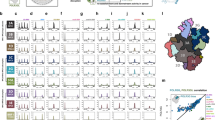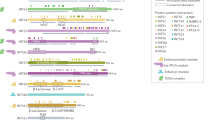Abstract
PTTG1 (vertebrate securin) is a separation inhibitor and regulates DNA repair and transcription. The protein is predominantly expressed in the second half of the S phase and at the G2 stage. With the onset of anaphase, securin is ubiquitinated by the APC/C complex and degraded rapidly. Increased expression of PTTG1 is associated with enhanced tumor cell growth and metastasis. Recently, we found a short securin isoform lacking the main APC/C recognition site (D-box) and the DNA-binding domain encoded by exons 3 and 4. The mRNA level of the short isoform in unsynchronized cells is 0.4–2% of the full-length one. We reported earlier on the ability of the short PTTG1 isoform to activate some of the genes controlled by the full-length protein. In this work, groups of genes, whose expression is altered by the action of the short and complete securin isoforms, were determined using RNA sequencing. Groups of genes whose mRNA levels are regulated by both protein isoforms and only one of the isoforms were identified. For a more detailed study of the effect of securin isoforms on the transcriptional program of cells, the NFYB gene, encoding the NF-Y transcription regulator subunit, was chosen. Our data showed that with overexpression of the short isoform, the level of NFYB mRNA decreased 2.4 ± 0.7 times, while the complete isoform did not significantly affect the expression of NFYB. 2.2-fold suppression of the short isoform of securin led to an increase in the expression of NFYB mRNA by 2.7 ± 0.3 times. Moreover, the mRNA expression of full-length securin increased by 2.7 ± 0.4 times. Since NFYB is associated with the PTTG1 promoter region, we suggest that the short isoform may be involved in regulation of the expression of the main isoform of securin by changing the level of this transcription factor. Since NFYB and PTTG1 are involved in the development of tumors and the formation of drug resistance, we assume that the short isoform of securin may play an important role in these processes. Thus, we showed the functional significance of the minor short isoform of securin.





Similar content being viewed by others
REFERENCES
Kalsotra A., Cooper T.A. 2011. Functional consequences of developmentally regulated alternative splicing. Nat. Rev. Genet.12, 715‒729.
Kim E., Magen A., Ast G. 2007. Different levels of alternative splicing among eukaryotes. Nucleic Acids Res.35, 125‒131.
Calarco J.A., Xing Y., Caceres M., Calarco J.P., Xiao X., Pan Q., Lee C., Preuss T.M., Blencowe B.J. 2007. Global analysis of alternative splicing differences between humans and chimpanzees. Gene Dev.21, 2963–2975.
Melamud E., Moult J. 2009. Stochastic noise in splicing machinery. Nucleic Acids Res.37, 4873‒4886.
Zou H., McGarry T.J., Bernal T., Kirschner M.W. 1999. Identification of a vertebrate sister-chromatid separation inhibitor involved in transformation and tumorigenesis. Science.285, 418‒422.
Roy Choudhury D., Small C., Wang Y., Mueller P.R., Rebel V.I., Griswold M.D., McCarrey J.R. 2010. Microarray-based analysis of cell-cycle gene expression during spermatogenesis in the mouse. Biol. Reproduction.83, 663‒675.
Romero F., Multon M.C., Ramos-Morales F., Dominguez A., Bernal J.A., Pintor-Toro J.A., Tortolero M. 2001. Human securin, hPTTG, is associated with Ku heterodimer, the regulatory subunit of the DNA-dependent protein kinase. Nucleic Acids Res.29, 1300‒1307.
Hatcher R.J., Dong J., Liu S., Bian G., Contreras A., Wang T., Hilsenbeck S.G., Li Y., Zhang P. 2014. Pttg1/securin is required for the branching morphogenesis of the mammary gland and suppresses mammary tumorigenesis. Proc. Natl. Acad. Sci. U. S. A.111, 1008‒1013.
Bernal J.A., Luna R., Espina A., Lazaro I., Ramos-Morales F., Romero F., Arias C., Silva A., Tortolero M., Pintor-Toro J.A. 2002. Human securin interacts with p53 and modulates p53-mediated transcriptional activity and apoptosis. Nat. Genet.32, 306‒311.
Cho-Rok J., Yoo J., Jang Y.J., Kim S., Chu I.S., Yeom Y.I., Choi J.Y., Im D.S. 2006. Adenovirus-mediated transfer of siRNA against PTTG1 inhibits liver cancer cell growth in vitro and in vivo.Hepatology.43, 1042‒1052.
Ishitsuka Y., Kawachi Y., Taguchi S., Maruyama H., Fujisawa Y., Furuta J., Nakamura Y., Otsuka F. 2012. Pituitary tumor-transforming gene 1 enhances proliferation and suppresses early differentiation of keratinocytes. J. Investigat. Dermatol.132, 1775‒1784.
Li W.H., Chang L., Xia Y.X., Wang L., Liu Y.Y., Wang Y.H., Jiang Z., Xiao J., Wang Z.R. 2015. Knockdown of PTTG1 inhibits the growth and invasion of lung adenocarcinoma cells through regulation of TGFB1/ SMAD3 signaling. Int. J. Immunopathol. Pharmacol.28, 45‒52.
Waizenegger I., Gimenez-Abian J.F., Wernic D., Peters J.M. 2002. Regulation of human separase by securin binding and autocleavage. Curr. Biol.: CB.12, 1368‒1378.
Ly T., Ahmad Y., Shlien A., Soroka D., Mills A., Emanuele M.J., Stratton M.R., Lamond A.I. 2014. A proteomic chronology of gene expression through the cell cycle in human myeloid leukemia cells. eLife.3, e01630.
Fang G., Yu H., Kirschner M.W. 1998. Direct binding of CDC20 protein family members activates the anaphase-promoting complex in mitosis and G1. Mol. Cell.2, 163‒171.
Tong Y., Tan Y., Zhou C., Melmed S. 2007. Pituitary tumor transforming gene interacts with Sp1 to modulate G1/S cell phase transition. Oncogene.26, 5596‒5605.
Wondergem B., Zhang Z., Huang D., Ong C.K., Koeman J., Hof D.V., Petillo D., Ooi A., Anema J., Lane B., Kahnoski R.J., Furge K.A., Teh B.T. 2012. Expression of the PTTG1 oncogene is associated with aggressive clear cell renal cell carcinoma. Cancer Res.72, 4361‒4371.
Huang J.L., Cao S.W., Ou Q.S., Yang B., Zheng S.H., Tang J., Chen J., Hu Y.W., Zheng L., Wang Q. 2018. The long non-coding RNA PTTG3P promotes cell growth and metastasis via up-regulating PTTG1 and activating PI3K/AKT signaling in hepatocellular carcinoma. Mol. Cancer.17, 93.
Guo X.C., Li L., Gao Z.H., Zhou H.W., Li J., Wang Q.Q. 2019. The long non-coding RNA PTTG3P promotes growth and metastasis of cervical cancer through PTTG1. Aging.11, 1333‒1341.
Xiang W., Wu X., Huang C., Wang M., Zhao X., Luo G., Li Y., Jiang G., Xiao X., Zeng F. 2017. PTTG1 regulated by miR-146a-3p promotes bladder cancer migration, invasion, metastasis and growth. Oncotarget.8, 664‒678.
Huang S., Liao Q., Li L., Xin D. 2014. PTTG1 inhibits SMAD3 in prostate cancer cells to promote their proliferation. Tumour Biol.35, 6265‒6270.
Zheng Y., Guo J., Zhou J., Lu J., Chen Q., Zhang C., Qing C., Koeffler H.P., Tong Y. 2015. FoxM1 transactivates PTTG1 and promotes colorectal cancer cell migration and invasion. BMC Med. Genomics.8, 49.
Lin Y.H., Tian Y., Wang J.S., Jiang Y.G., Luo Y., Chen Y.T. 2015. Pituitary tumor-transforming gene 1 regulates invasion of prostate cancer cells through MMP13. Tumour Biol.37, 15495–15500.
Genkai N., Homma J., Sano M., Tanaka R., Yamanaka R. 2006. Increased expression of pituitary tumor-transforming gene (PTTG)-1 is correlated with poor prognosis in glioma patients. Oncol. Repts.15, 1569‒1574.
Fujii T., Nomoto S., Koshikawa K., Yatabe Y., Teshigawara O., Mori T., Inoue S., Takeda S., Nakao A. 2006. Overexpression of pituitary tumor transforming gene 1 in HCC is associated with angiogenesis and poor prognosis. Hepatology.43, 1267–1275.
Feng Z.Z., Chen J.W., Yang Z.R., Lu G.Z., Cai Z.G. 2012. Expression of PTTG1 and PTEN in endometrial carcinoma: Correlation with tumorigenesis and progression. Med. Oncol.29, 304‒310.
Demeure M.J., Coan K.E., Grant C.S., Komorowski R.A., Stephan E., Sinari S., Mount D., Bussey K.J. 2013. PTTG1 overexpression in adrenocortical cancer is associated with poor survival and represents a potential therapeutic target. Surgery.154, 1405‒1416; discussion 1416.
Wei C., Yang X., Xi J., Wu W., Yang Z., Wang W., Tang Z., Ying Q., Zhang Y. 2015. High expression of pituitary tumor-transforming gene-1 predicts poor prognosis in clear cell renal cell carcinoma. Mol. Clin. Oncol.3, 387‒391.
Xu M.D., Dong L., Qi P., Weng W.W., Shen X.H., Ni S.J., Huang D., Tan C., Sheng W.Q., Zhou X.Y., Du X. 2016. Pituitary tumor-transforming gene-1 serves as an independent prognostic biomarker for gastric cancer. Gastric Cancer.19, 107‒115.
Demin D.E., Bogolyubova A.V., Zlenko D.V., Uvarova A.N., Deikin A.V., Putlyaeva L.V., Belousov P.V., Mit’kin N.A., Korneev K.V., Sviryaeva E.N., Kulakovskiy I.V., Tatosyan K.A., Kuprash D.V., Schwartz A.M. 2018. The novel short isoform of securin stimulates the expression of cyclin D3 and Angiogenesis Factors VEGFA and FGF2, but does not affect the expression of MYC transcription factor. Mol. Biol. (Moscow). 52, 508‒518.
Bolger A.M., Lohse M., Usadel B. 2014. Trimmomatic: A flexible trimmer for Illumina sequence data. Bioinformatics.30, 2114‒2120.
Dobin A., Davis C.A., Schlesinger F., Drenkow J., Zaleski C., Jha S., Batut P., Chaisson M., Gingeras T.R. 2013. STAR: Ultrafast universal RNA-seq aligner. Bioinformatics.29, 15‒21.
Liao Y., Smyth G.K., Shi W. 2014. Feature counts: An efficient general purpose program for assigning sequence reads to genomic features. Bioinformatics.30, 923‒930.
Love M.I., Huber W., Anders S. 2014. Moderated estimation of fold change and dispersion for RNA-seq data with DESeq2. Genome Biol.15, 550.
Chu C.P., Hokamp J.A., Cianciolo R.E., Dabney A.R., Brinkmeyer-Langford C., Lees G.E., Nabity M.B. 2017. RNA-seq of serial kidney biopsies obtained during progression of chronic kidney disease from dogs with X-linked hereditary nephropathy. Sci. Repts.7, 16776.
Tripathi S., Pohl M.O., Zhou Y., Rodriguez-Frandsen A., Wang G., Stein D.A., Moulton H.M., DeJesus P., Che J., Mulder L.C., Yanguez E., Andenmatten D., Pache L., Manicassamy B., Albrecht R.A., et al. 2015. Meta- and orthogonal integration of influenza “OMICs” data defines a role for UBR4 in virus budding. Cell Host Microbe.18, 723‒735.
Thul P.J., Akesson L., Wiking M., Mahdessian D., Geladaki A., Blal H.A., Alm T., Asplund A., Bjork L., Breckels L.M., Backstrom A., Danielsson F., Fagerberg L., Fall J., Gatto L., et al. 2017. A subcellular map of the human proteome. Science. 356.
Li X.Y., Mantovani R., Vanhuijsduijnen R.H., Andre I., Benoist C., Mathis D. 1992. Evolutionary variation of the CCAAT-binding transcription factor Nf-Y. Nucleic Acids Res.20, 1087‒1091.
Benatti P., Chiaramonte M.L., Lorenzo M., Hartley J.A., Hochhauser D., Gnesutta N., Mantovani R., Imbriano C., Dolfini D. 2016. NF-Y activates genes of metabolic pathways altered in cancer cells. Oncotarget.7, 1633‒1650.
Moeinvaziri F., Shahhoseini M. 2015. Epigenetic role of CCAAT box-binding transcription factor NF-Y on ID gene family in human embryonic carcinoma cells. IUBMB Life.67, 880‒887.
Jiang X., Nevins J.R., Shats I., Chi J.T. 2015. E2F1-mediated induction of NFYB attenuates apoptosis via joint regulation of a pro-survival transcriptional program. PloS One.10, e0127951.
Fang Z., Gong C., Yu S., Zhou W., Hassan W., Li H., Wang X., Hu Y., Gu K., Chen X., Hong B., Bao Y., Chen X., Zhang X., Liu H. 2018. NFYB-induced high expression of E2F1 contributes to oxaliplatin resistance in colorectal cancer via the enhancement of CHK1 signaling. Cancer Lett.415, 58‒72.
Yevshin I., Sharipov R., Valeev T., Kel A., Kolpakov F. 2017. GTRD: A database of transcription factor binding sites identified by ChIP-seq experiments. Nucleic Acids Res.45, D61‒D67.
Yevshin I., Sharipov R., Kolmykov S., Kondrakhin Y., Kolpakov F. 2019. GTRD: A database on gene transcription regulation-2019 update. Nucleic Acids Res.47, D100‒D105.
Funding
The study was carried out with financial support from the Russian Foundation for Basic Research under scientific project no. 18-34-00628 mol_a.
Author information
Authors and Affiliations
Corresponding author
Ethics declarations
COMPLIANCE WITH ETHICAL STANDARDS
The study did not use biological materials obtained from humans or animals.
Conflict of Interest. The authors declare they have no conflict of interest.
Additional information
Abbreviations: PTTG1, Pituitary Tumor-Transforming Gene-1; APC/C, Anaphase Promoting Complex/Cyclosome; NFYB, Nuclear Transcription Factor Y Subunit Beta.
Supplementary material
Rights and permissions
About this article
Cite this article
Demin, D.E., Uvarova, A.N., Klepikova, A.V. et al. The Influence of the Minor Short Isoform of Securin (PTTG1) on Transcription is Significantly Different from the Impact of the Full Isoform. Mol Biol 54, 43–50 (2020). https://doi.org/10.1134/S0026893320010045
Received:
Revised:
Accepted:
Published:
Issue Date:
DOI: https://doi.org/10.1134/S0026893320010045




